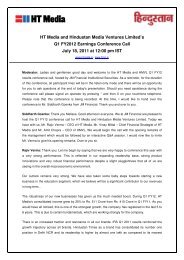Download latest annual report - HT Media
Download latest annual report - HT Media
Download latest annual report - HT Media
You also want an ePaper? Increase the reach of your titles
YUMPU automatically turns print PDFs into web optimized ePapers that Google loves.
Annual Report 2011-12<br />
102<br />
amortization and accumulated impairment losses, if<br />
any. Internally generated intangible assets, excluding<br />
capitalized development costs, are not capitalized and<br />
expenditure is reflected in the statement of profit and<br />
loss in the year in which the expenditure is incurred. The<br />
following are the intangible assets recognised by the group<br />
Value for individual software license acquired from the<br />
holding company in an earlier year is allocated based<br />
on the valuation carried out by an independent expert<br />
Software licenses acquired from the holding company,<br />
which are estimated to have lower residual lives<br />
than that envisaged above, are amortised over such<br />
estimated lower residual lives.<br />
Purchased copyrights by a subsidiary are accounted for<br />
at costs. In case of slump purchases by a subsidiary,<br />
value for copyright acquired is allocated based on the<br />
valuation carried out by an independent expert at the<br />
time of acquisition<br />
Costs incurred by one of the subsidiary in planning or<br />
conceptual development of the web site are expensed<br />
as incurred. Once the planning or conceptual<br />
development of a web site has been achieved, and<br />
the project has reached the application development<br />
stage, the Group capitalizes all costs related to web site<br />
application and infrastructure development including<br />
costs relating to the graphics and content development<br />
stages. Training and routine maintenance costs are<br />
expensed as incurred.<br />
Intangible assets are amortized on a straight line basis<br />
over the estimated useful economic life. The company<br />
uses a rebuttable presumption that the useful life<br />
of an intangible asset will not exceed ten years from<br />
the date when the asset is available for use. If the<br />
persuasive evidence exists to the affect that useful life<br />
of an intangible asset exceeds ten years, the company<br />
amortizes the intangible asset over the best estimate<br />
of its useful life. Such intangible assets and intangible<br />
assets not yet available for use are tested for impairment<br />
<strong>annual</strong>ly, either individually or at the cash-generating<br />
unit level. All other intangible assets are assessed for<br />
impairment whenever there is an indication that the<br />
intangible asset may be impaired.<br />
The amortization period and the amortization method<br />
are reviewed at least at each financial year end. If the<br />
expected useful life of the asset is significantly different<br />
from previous estimates, the amortization period is<br />
changed accordingly. If there has been a significant<br />
change in the expected pattern of economic benefits<br />
from the asset, the amortization method is changed<br />
to reflect the changed pattern. Such changes are<br />
accounted for in accordance with AS 5 Net Profit or<br />
Loss for the Period, Prior Period Items and Changes in<br />
Accounting Policies.<br />
Gains or losses arising from derecognition of an<br />
intangible asset are measured as the difference between<br />
the net disposal proceeds and the carrying amount of<br />
the asset and are recognized in the statement of profit<br />
and loss when the asset is derecognized.<br />
License fees are changed to revenue at the rate of 4%<br />
of gross revenue for the period or 10% of Reserve<br />
One Time Entry Fee (ROTEF) for the concerned city,<br />
whichever is higher by a subsidiary company. Gross<br />
Revenue for this purpose is revenue derived on the<br />
basis of billing rates inclusive of any taxes and without<br />
deduction of any discount given the advertiser and<br />
any commission paid to advertising agencies. ROTEF<br />
means 25% of highest valid bid in the city.<br />
Software licenses costing below `5,000 each are fully<br />
depreciated in the year of acquisition.<br />
A summary of amortization policies applied to the<br />
company’s intangible assets is as below:<br />
Useful life (in years)<br />
Website Development 6<br />
Software Licenses 5-6<br />
License Fees (one time entry fee) 10<br />
Music Contents (for Radio Business) 4<br />
Purchased Copy rights 6<br />
e) Goodwill on Consolidation<br />
Goodwill represents the difference between the Group’s<br />
share in the net worth of the investee companies and<br />
the cost of acquisition at each point of time of making<br />
the investment. For this purpose, the Groups’ share of<br />
equity in the investee companies are determined on the<br />
basis of the <strong>latest</strong> financial statements of the respective<br />
companies available as on the date of acquisition, after<br />
making necessary adjustments for material events<br />
between the date of such financial statements and the<br />
date of respective acquisition.<br />
For acquisitions done till 2005-06, Goodwill is<br />
amortised pro-rata over a period of 5 years from the<br />
date of acquisition. For acquisitions done, Goodwill is<br />
tested for impairment<br />
f) Expenditure on new projects and substantial expansion<br />
Expenditure directly relating to construction activity<br />
is capitalized. Indirect expenditure incurred during<br />
construction year is capitalized as part of the indirect<br />
construction cost to the extent to which the expenditure<br />
is directly related to construction or is incidental thereto.<br />
Other indirect expenditure (including borrowing costs)<br />
incurred during the construction year, which is not<br />
related to the construction activity nor is incidental<br />
thereto is charged to the Statement of Profit & Loss.<br />
Income earned during construction year is adjusted<br />
against the total of the indirect expenditure.<br />
All direct capital expenditure incurred on expansion<br />
is capitalized. As regards indirect expenditure on<br />
expansion, only that portion is capitalized which<br />
represents the marginal increase in such expenditure<br />
involved as a result of capital expansion. Both direct<br />
and indirect expenditure are capitalized only if they<br />
increase the value of the asset beyond its originally<br />
assessed standard of performance.<br />
g) Leases<br />
Where the Group is lessee<br />
Finance leases, which effectively transfer to the Group<br />
substantially all the risks and benefits incidental to<br />
ownership of the leased item, are capitalized at the<br />
inception of the lease term at the lower of the fair





